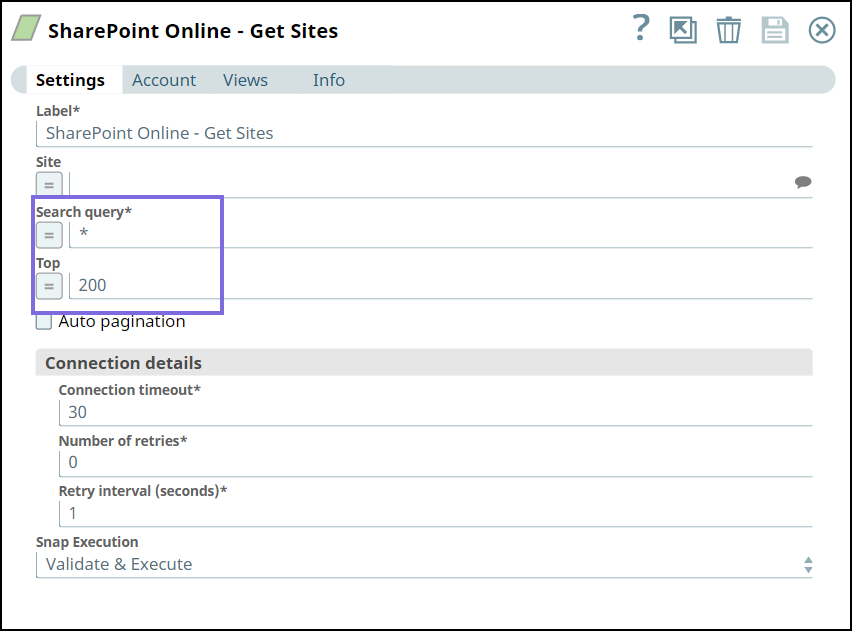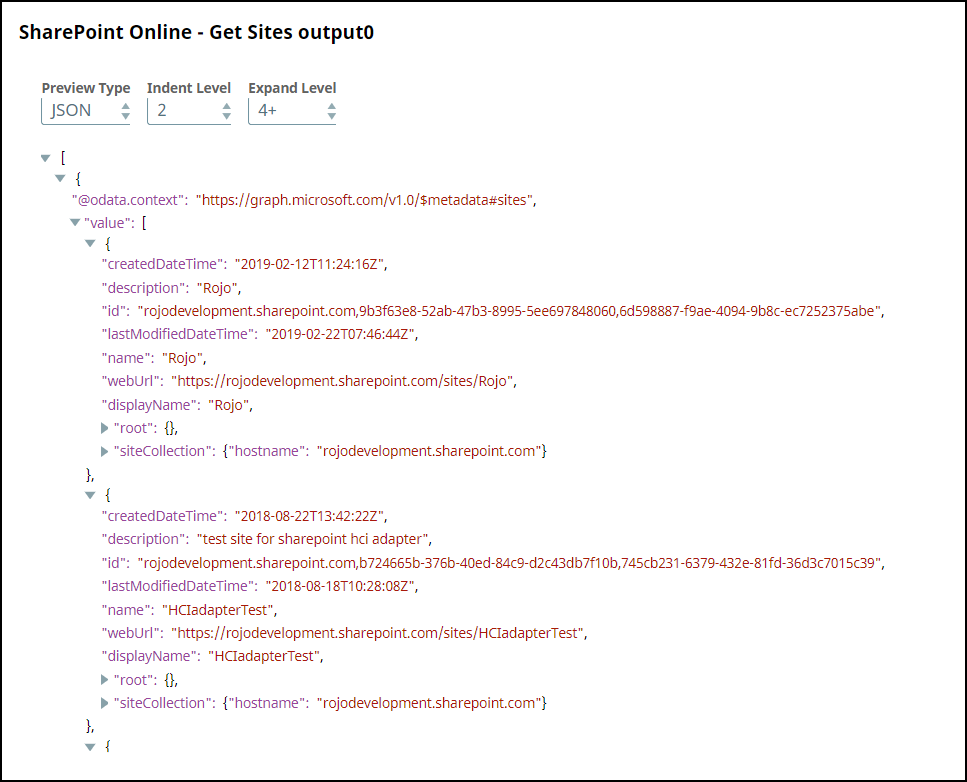In this article
Overview
You can use this Snap to retrieve specific metadata information of a specific site and retrieve the sub-sites of the selected site.
Snap Type
SharePoint Online - Get Sites is a Read-type Snap that enables you to get the list of sites specific to the logged-in user from the SharePoint Online site.
Prerequisites
Valid SharePoint Online tenant and associated site.
Valid application in Azure portal with all the required API permissions.
Support for Ultra Pipelines
Works in Ultra Pipelines. However, we recommend that you not use this Snap in an Ultra Pipeline.
Limitations and Known Issues
None.
Snap Views
View Type | View Format | Number of Views | Examples of Upstream and Downstream Snaps | Description |
|---|---|---|---|---|
Input | Document |
|
| A document containing the metadata information that needs to get the document library metadata. |
Output | Document |
|
| A document containing the metadata of the document library or a complete list of document libraries in the mentioned site. |
Error | Error handling is a generic way to handle errors without losing data or failing the Snap execution. You can handle the errors that the Snap might encounter when running the Pipeline by choosing one of the following options from the When errors occur list under the Views tab:
Learn more about Error handling in Pipelines. | |||
Snap Settings
Asterisk (*): Indicates a mandatory field.
Suggestion icon (
 ): Indicates a list that is dynamically populated based on the configuration.
): Indicates a list that is dynamically populated based on the configuration.Expression icon (
 ): Indicates whether the value is an expression (if enabled) or a static value (if disabled). Learn more about Using Expressions in SnapLogic.
): Indicates whether the value is an expression (if enabled) or a static value (if disabled). Learn more about Using Expressions in SnapLogic.Add icon (
 ): Indicates that you can add fields in the field set.
): Indicates that you can add fields in the field set.Remove icon (
 ): Indicates that you can remove fields from the field set.
): Indicates that you can remove fields from the field set.
Field Name | Field Type | Field Dependency | Description | |
|---|---|---|---|---|
Label* Default Value: SharePoint Online - Get Sites | String | N/A | Specify the name for the Snap. You can modify this to be more specific, especially if you have more than one of the same Snap in your Pipeline. | |
Site* Default Value: N/A | String/Expression | Displays Enumerate subsites checkbox. | Specify the name of a site which contains the list of document library to be used in the subsequent Snap settings. | |
Enumerate subsites Default Value: Deselected | Checkbox | Appears when you specify or select a value in the Site field. | Select this checkbox to get a collection of subsites available for a site. | |
Search Query* Default Value: * | String/Expression | Appears when you select the Enumerate subsites checkbox. | Specify keywords that match with one or more site names, as needed. The Snap searches and returns matching sites. This field is hidden if you select a specific site to retrieve the metadata information. | |
Top Default Value: 200 | Integer/Expression | Appears when you select the Enumerate subsites checkbox. | Specify the number of records to be read from the matched search results. | |
Auto Pagination Default Value: Deselected | Checkbox | N/A | Select this checkbox to retrieve all matching site names as a paginated list. If you select the Auto Pagination checkbox, the Top field is hidden. | |
Connection details | Use this field set to specify connection properties to the SharePoint Online APIs. | |||
Connection timeout* Default Value: 30 | Integer | N/A | Specify the connection timeout duration in seconds. | |
Number of retries* Default Value: 0 | Integer | N/A | Specify the maximum number of reconnections in case of a connection failure or timeout. | |
Retry interval (seconds)* Default Value: 1 | Integer | N/A | Specify the time interval in seconds between connection attempts. | |
Snap Execution Default Value: Validate & Execute | Dropdown list | N/A | Specify the required Pipeline execution type:
| |
For more information about how to get the metadata of an item in the SharePoint Online, refer to the list-document-library in Graph API documentation.
Troubleshooting
Error | Reason | Resolution |
|---|---|---|
Site name {siteName} is not found in the tenant. | The site name that you have entered is not available in the tenant. | Click the Suggestion |
Forbidden exception. | Either the user or the app does not have sufficient permissions to read the metadata for the document library. | Ensure that you provide both user-level and app-level permissions required to access the metadata. |
Example
Retrieving Sites List
This example demonstrates how to retrieve the list of sites of a user who is authenticated while creating the account. This example assumes that you have configured and authorized a valid account for the SharePoint Online - Get Sites Snap. For more information about configuring account, see SharePoint Online Account.
First, we configure the SharePoint Online - Get Sites Snap as follows to get the list of sites. We leave the default values as is.
After successfully validating the Pipeline, the Snap gets all the sites from SharePoint Online and displays the first 200 matching sites in the page.
Next, we connect the JSON Formatter Snap to format the output into a JSON file, and finally write the file to the database using the File Writer Snap.
Downloads
Important Steps to Successfully Reuse Pipelines
Download and import the Pipeline into SnapLogic.
Configure Snap accounts as applicable.
Furnish Pipeline parameters as applicable.
Snap Pack History
Related Content
SharePoint Online - Upload File



